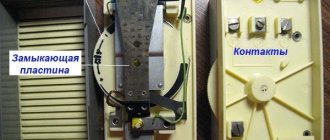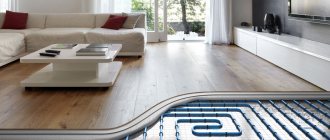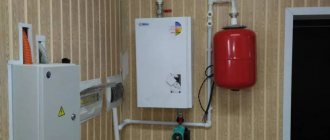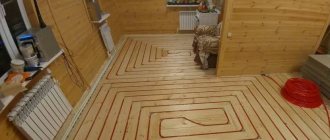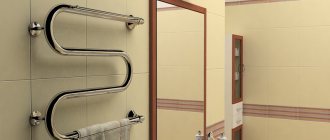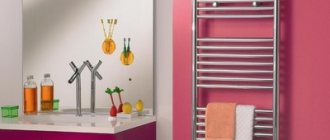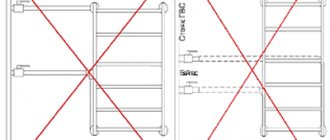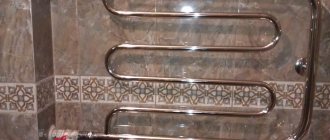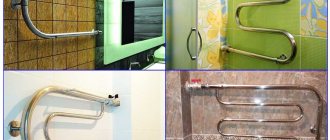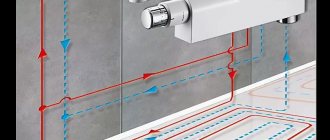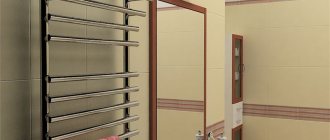On trading platforms, the range of heating radiators includes electric, water or combined equipment for wet rooms, which is also used for drying textiles. The heated towel rail is installed on the walls or floor with a connection to the wiring, heating or hot water supply system. Let's consider the features of installation of units depending on the heat source, the location of the pipes and the rules prescribed in SNiP.
Electric dryer Source pinimg.com
Overview of types of heated towel rails for baths
Classification of heated towel rails is carried out according to the coolant, installation method, shape, type of connection and materials of manufacture. So, the source of heat is electricity or a heating network. Depending on their location, there are wall-mounted, floor-mounted, stationary or rotary models. Design execution is based on the following standards:
- coil;
- steps:
- bowl;
- spiral.
The heated towel rail is connected to the electrical network or water supply diagonally, horizontally or vertically. For the production of water equipment, metal is used:
- Seamless stainless steel with walls greater than 3 mm and a diameter of ¾-1 inch copes with the pressure in the city heating network.
- Black steel is only permissible for autonomous systems, since the internal surface does not have anti-corrosion protection.
- Copper quickly acquires the temperature of the coolant, but the inner surface of the pipe must be insulated from direct contact with water.
- Brass is protected by a chrome layer, but is sensitive to pressure changes.
Copper radiator for the bathroom Source pechiexpert.ru
Electrical units are equipped with a heating element, which transfers thermal energy to the coolant liquid. This could be technical oil, antifreeze or water. Another option involves pulling a heating cable through the channels.
The dimensions of a water heated towel rail have a wide range of values depending on the design. Thus, U-shaped products are often 32 cm in height, ladders are 50-120 cm, and coils are up to 60 cm. The width of all products is in the range of 40-80 cm, which can be explained by the small dimensions of the bathroom and its purpose for drying small textiles.
An independent approach to the manufacture of a water heated towel rail allows the use of metal-plastic or polypropylene pipes. It is important to observe the restrictions on channel bending and the diameter, which must match or exceed that of the water supply.
Polypropylene pipe dryer Source beliashou.com
Combined products are connected to a seasonal central heating system and the electrical network. Such equipment provides heating of a damp room in the summer and in emergency situations at a heating station.
Combined dryer for wet rooms Source yandex.net
Dismantling the old device
You should start by disassembling the old heated towel rail . For this:
- Having agreed with the neighbors at the entrance and the management company, we shut off the heating riser and drain the water from it.
- If the old structure was welded to the riser pipes, cut it off with a grinder. In the case of a detachable connection, unscrew the fastening couplings.
- In rare cases when the installation dimensions of a new device coincide with the old ones, we can consider ourselves very lucky. Most often this is not the case and you have to cut the pipes even with a collapsible connection .
- The cutout in the riser must be higher in height than the distance between the inlet pipes of the new heated towel rail by the length of the pipes and couplings required for inserting the bypass.
- When cutting, we take into account not only the installation dimensions of the new device, but also the possibility of cutting threads on pipes.
- We remove the old device from the wall by cutting off its brackets with a grinder or a hacksaw.
Building regulations
The height of the lower edge of the heated towel rail from the floor, based on SNiPs, is permissible at 90 cm, provided that it is an M-shaped coil or a ladder. The top edge should not be higher than 1.70 m. For a bowl, the value is 30 cm higher, and for the combined type 1 m. It is recommended to maintain a distance of 60 cm from the doorway and wall cabinets with shelves. The same applies to the mixer, bathtub, shower cabin. For electrical appliances, the minimum distance is 70 cm.
In small bathrooms, standards are often violated. This can be explained by the lack of standards in the construction and engineering of bathrooms. But there are requirements that must be met in any case:
- access to all communications must be open;
- using the dryer should be safe and comfortable;
- cannot be hung over a bathtub, but is acceptable over a sink or side-loading washing machine;
Electric rotary dryer Source dizainexpert.ru
- sockets must be grounded and connected to a separate circuit breaker; they can be installed indoors only if there is proper ventilation;
- the distance from the wall is maintained in accordance with the thermal expansion of the finishing material of the walls, but not less than 30-55 mm.
The dimensions of the heated towel rail are determined by the owner of the bathroom, but it is not recommended to violate the maximum distances between other objects. The manufacturer, in the product instructions, indicates the area that the product is designed to heat under certain conditions.
For example, at a coolant temperature of +70℃ and a heat output of the unit of 100 W, the serviced cubic capacity of the room will be equal to 2.5 cubic meters. m. Upon closer examination of the issue, the ratio of the volume of the bathroom and the parameters of the dryers approximately looks like this:
- up to 6 cubic meters – 50*40-60 cm;
- up to 8 cubic meters – 60*40-60 cm;
- up to 11 cubic meters – 80*40*60 cm;
- up to 14 cubic meters – 100*40-60 cm;
- more than 14 cubic meters – 120*40-80 cm.
Among other things, it is important to consider the weight of the equipment with components and coolant. Not every foundation can cope with the total load.
Consequences of incorrect calculation of the load of the unit on the wall Source filesonload.ru
See also: Catalog of companies that specialize in heating, water supply and sewerage systems
As a result, you will have to either strengthen the wall and floor, or choose a different design in terms of material, shape or size.
Advantages of connecting to a hot water riser
Connecting a dryer to a domestic hot water system has a number of undeniable advantages:
- eliminating dampness in the bathroom;
- uninterrupted operation of the device;
- Constantly comfortable temperature in the room.
In addition, there is an opportunity to save on utility bills. Connecting the dryer to the hot water supply line allows you to not consider it a heating device. The thermal energy consumed will be taken into account as for heating water, and will not be transferred to the heating bill as gigacalories.
Installation of an electric heated towel rail
Installation of electrical equipment in a wet area requires protective measures to ensure safe use. This is a separate RCD, grounding and the installation height of the heated towel rail socket is at least 70 cm from the floor. The connection is made by installing the latter inside or outside the bathroom.
The electrical socket must be protected by a sealed housing and a cover with a rubber seal. It is permissible to place the device on a wall with minimal moisture load, but not bordering the street. This is explained by the difference in temperatures, due to which there is a high possibility of condensation forming in the seat.
The most reliable option is to lay serviced communications in the body of the wall.
Hidden installation of electrical wiring with socket Source mainavi.ru
To do this, grooves and recesses are formed for the socket, through holes for bringing the latter out. Filling the voids with plaster mortar and finishing materials will protect the wiring from contact with moisture. External installation with a high degree of insulation is also acceptable. The cable for installing the heated towel rail is placed at a height of more than 10 cm from the floor, so that it later leads to a short circuit.
Connection procedure
The cable, machine and socket are selected with a small power reserve relative to the connected equipment. So, for example, 1.8 kW is divided by 220 V, and 8.2 A is obtained. The cable must have a copper conductor cross-section of at least 1 sq. mm. With respect to furniture they maintain 750 mm, corners - 300 mm, floors - 200 mm.
The heated towel rails to be hung are applied to the area permissible for installation, and the position of the brackets is noted. Mounting holes are drilled and the equipment is fixed to the wall. Stationary floor models are fixed to the base according to the same scheme. Next, connect to the power source. The socket should be at a distance of 25-35 cm to the side of the device.
Correct location of the outlet for the dryer in the bathroom Source maxi-svet.by
Welding of polypropylene pipes
We will connect the heated towel rail using polypropylene pipes. Why polypropylene? This is the best option.
The most common materials for supply pipes are steel, copper, and polypropylene:
- Steel pipes are heavy, susceptible to corrosion, and require a welding machine for installation.
- Copper ones do not rust, but are very expensive and are mounted by soldering.
- Polypropylene is not subject to corrosion, is cheap, and lightweight. Reinforcement with special fiber significantly increases their strength and resistance to high temperatures. The presence of a variety of fittings makes it easy to connect polypropylene to metal pipes. They are very easy to install. For this, there are special welding devices that you can master in just half an hour and easily make high-quality connections. In addition, these devices can be rented at most stores that sell plastic pipes and building materials. This service costs approximately 400 rubles per day.
You can read more about soldering and installation of polypropylene pipes here.
Installation of a water heated towel rail
The installation of a heated towel rail with water coolant is pre-coordinated with utility services. This is necessary to determine the time to turn off the water supply service. The unit is connected to general communications in the same way as the developer did. Reworking the system can lead to changes in pressure and temperature in the network, and less often to depressurization of the main line.
Water models operate by connecting to a heating network or hot water supply system. In this way, the coolant circulates through the pipes of the heated towel rail. The choice of equipment is determined by the pressure in the service line:
- old stock – 5-7 atm;
- new buildings – up to 10 atm;
- autonomous system – as a rule, below 1.5 Atm.
It is also necessary to read the recommendations from the manufacturer. So, there are models that are not allowed to be connected to the hot water supply. In this case, units intended for installation in the water supply system can be embedded in the heating circuit. And there are coils for installation in any water main.
Connecting equipment to hot water supply Source mirvannaja.ru
Before connecting a heated towel rail to a hot water supply or domestic hot water system, you need to familiarize yourself with the pros and cons of the solutions. So, in the first case, there is a seasonal dependence and the presence of a system with a water coolant. But the circulation of the environment occurs around the clock. In the second case, the heating of the unit occurs during active use of hot water, which is why the pipes are noticeably colder at night than during the day. But the equipment works all year round.
Replacing a heated towel rail in a centrally serviced building with an analogue from the developer can be done independently. It will be enough to agree on the suspension of water circulation. If the devices differ from the original ones, then the drafting and approval of documents by the housing and communal services will be required.
To understand how to connect a heated towel rail, you need to familiarize yourself with the general requirements:
- narrowing the diameter of the coolant source is unacceptable;
- a bypass is installed between the riser or water supply and the unit;
Location of the bypass in front of the heated towel rail Source mhremont.ru
installation of shut-off valves on the jumper and in the area between it and the supply main is excluded.
The bypass will ensure that water circulation is maintained in the central system in the event of a heated towel rail failure. If you install ball valves in front of the equipment, it will be possible to repair or replace the device without coordinating the event with utility services.
Summing up
Analyze the old diagram: diameters, presence of a jumper, feed direction. Try to keep the pipe sections unchanged. When connecting the heated towel rail, follow the recommendations given and the manufacturer's instructions.
Check the functioning of the assembled circuit before finishing finishing work. The dryer is left connected for half a day. A test run will allow you to identify leaks, heating problems, and eliminate shortcomings while access to the wiring is free.
Advice! If you need bathroom renovation specialists, there is a very convenient service for selecting specialists from PROFI.RU. Just fill out the order details, the experts will respond and you can choose who to collaborate with. Each specialist in the system has a rating, reviews and examples of work, which will help with the choice. Looks like a mini tender. Placing an application is FREE and does not oblige you to anything. Works in almost all cities of Russia.
If you are a master, follow this link, register in the system and be able to accept orders.
Video description
The video discusses in detail the advantages of installing a bypass:
Installation diagrams for a water heated towel rail
For most models, the working medium is supplied through the top outlet, and the outlet is provided from the bottom. This is a universal approach that can be applied to any design. In addition, there are other advantages:
- efficiency does not depend on the pressure in the serviced network and the direction of water movement;
- air does not accumulate in the pipes of the unit;
- the distance from the highway is determined by the desire of the bathroom owner.
Lateral connection of drying equipment Source polotenhik.ru
Let's consider how to install a heated towel rail with a lateral or diagonal connection so that the equipment functions correctly:
- The slope of the pipes should be 20-30 mm when water enters towards the heated towel rail, and when exiting towards the main line. The exception is pipes with a diameter of 32 mm at a distance of up to 200 cm. Then it is permissible to maintain a horizontal level.
- The supply contours must only be level. Any curvature will provoke the formation of air with subsequent disruption of the natural circulation of fluid.
- Connecting pipes for devices with steel lines can be at least ¾ inch in diameter. For reinforced polypropylene the limit is 25 mm.
For hidden connections, experts recommend resorting to thermal insulation measures. This applies to plastic pipelines. For this purpose, polystyrene foam sleeves or polyurethane foam shells are often used. The materials are resistant to temperature changes, moisture, inert to biological damage and serve for a long time.
Insulation of connecting circuits and water supply Source montagtrub.ru
How to place taps (connection methods)
For lateral and diagonal connections, the outlets should be located at the same level as the heated towel rail inlets or slightly higher/lower. What definitely won’t work is installing a heated towel rail if the outlets are located at a distance less than the distance between the inputs. The photo below is an example of a non-working diagonal connection with closely spaced taps. The option for correcting it (top feed) is indicated in black.
With a side connection, the heated towel rail will only work if the outlets are located slightly above and slightly below its inputs or at least on the same level
When connecting, the taps must be positioned strictly horizontally or slightly at an angle. Slightly at an angle - this is from 2 cm per meter (2%) or maybe a little more. The direction of the slope depends on the connection diagram and which end this outlet will be connected to. To make it a little clearer, let’s look at several typical connection diagrams for heated towel rails.
Universal bottom connection for heated towel rail "ladder"
This circuit works regardless of the direction of hot water supply. Connection type - bottom, both outlets should be located lower than the bottom edge of the dryer. With top feed, an option is acceptable when the edge is located between the bends, but the work may not be so efficient (it may heat up worse).
Universal connection for heated towel rail (bottom)
In this scheme, you can install shut-off valves. For its normal operation you need:
- Mayevsky valves (air vents) installed on the upper outlets to release air accumulated in the upper part. They will need to be periodically opened and vented (as the heat begins to worsen). There is an option - install automatic air vents. They are also compact. This will make it easier to use.
- The bypass is straight and narrowed. The size of the narrowing is a pipe of one step smaller in diameter.
- Bends are made with a pipe of a step smaller in diameter than the main riser.
If this option suits your height, do it. The scheme works in any conditions, with ladder-type heated towel rails of any type.
Possible bottom connection for top supply
When pouring hot water from above, you can make the upper outlet higher than the bottom edge of the dryer. With the bypass displaced and narrowed, it should heat up normally. This method is not the best, but it works.
Working option for top spill of hot water
The presence of air vents and bleeding of air after the system is stopped are mandatory.
Universal side connection
You can connect the pipes from the side to the heated towel rail in any of the standard shapes - U-shaped, snake and ladder. The connection itself does not depend on the form. The standard version comes with a straight, unnarrowed bypass. Bends are either strictly horizontal or with a slight slope. There is a slope in the figure: the end of the upper branch is tilted slightly downwards (2 cm by 1 meter), the lower one is tilted slightly upwards. The diameter of the outlets is not less than the diameter of the heated towel rail.
Lateral universal connection for heated towel rail
This connection diagram is good because there is no need to install air vents on the “ladder” (they install plugs), since the air simply goes into the riser.
With the top supply on the bypass, you can narrow it and/or move the jumper towards the heated towel rail. This will improve circulation and the dryer will heat up better. But once again: such a scheme will only work with top water supply.
When supplying water from above, the bypass can be shifted and made into a pipe with a smaller diameter step
With this scheme, it is also possible to make bends at a slight angle or strictly horizontally.
Possible side connection option (not the best)
A lateral connection scheme with the top outlet located below the top edge of the heated towel rail is acceptable. But with such a connection, Mayevsky taps are needed, through which you will have to bleed the air after turning off the hot water supply for repairs/maintenance. It may also be necessary to periodically remove air during the process.
Not the best, but quite a workable option
Diagonal connection
There is no particular point in the diagonal connection of most heated towel rails: their efficiency is no different from the side one (in any case, there is no significant improvement), but the pipe consumption is greater, longer grooves are required, and this is labor-intensive. Although the scheme is workable.
The diagonal works fine if the water supply comes from above. Then the upper outlet is connected to the far edge of the “ladder”, and the lower one to the near one.
Diagonal connection with top feed
In this case, you can also make a narrowed and offset bypass, but even without this everything should work with a bang. With bottom supply, the bypass is not narrowed, exactly along the riser, connection
Heated towel rails with complex shapes: how to connect
In the case of connecting heated towel rails of complex shape, in addition to the usual means, it is also necessary to take into account the structural features of each specific model. They must be considered from the point of view of hydrodynamics - where water flows best, water is supplied there. For example, the popular model “Elegy” from Sunerge. This is not a ladder or a zig-zag.
A diagonal connection is chosen here, because anything else simply won’t work.
Installation of the Sunerzhi Elegy heated towel rail was chosen from the side, since with any other installation the circulation will be disrupted. There are no options at all.
Another model with a bottom connection and a complex design has three installation options. Provided water is supplied from above, the second one will work best, the first one will work a little worse, and the third one will be the most ineffective.
Bottom connection options with top spill
When feeding from below, options 1 and 3 remain, but only without narrowing the bypasses - it will interfere, not help. We exclude the second option completely.
Video description
From the video you can learn how to connect a dryer at a great distance from the riser:
How to properly connect a heated towel rail to a hot water riser using fittings:
- The taps are installed between the pipes and the dryer. If there is already a thread on them, then it is worth correcting it with a die to ensure a tight connection.
- It is important to secure the fittings correctly here. They are prefabricated, so there is a seam on the body. It should be directed in the direction of the flow.
- Flax is used for compaction.
- The final fixation after manual tightening is carried out with a key ¼-½ full turn.
If you violate these simple rules, a leak will soon appear, a seam will rupture, or a nut will burst.
The last thing you need to do before launching the system is testing. To do this, turn on the riser for a short period of time. This will be enough to determine the tightness of the structure. If everything is in order, then you can put the heated towel rail into operation. Otherwise, eliminate the deficiencies and repeat the test again.
Leak detected during system testing Source www.tproekt.com
Required materials
Before installation, it is important to check the equipment of the device, familiarize yourself with the design, connection diagram of the new dryer, and also study the instructions. It is best to prepare the necessary materials and tools in advance.
- directly purchased heated towel rail;
- brackets;
- PVC pipes of the required diameter (26 and 32 mm);
- screwdriver;
- turbine;
- fasteners;
- knife for cutting PVC pipes;
- construction level and hammer;
- two adjustable wrenches;
- two or three ball valves;
- tow or some other sealant;
- two union solder nuts;
- soldering iron for PVC pipes;
- PVC elbows;
- one PVC elbow with internal thread;
- two tees (if you install a jumper);
- one coupling with internal thread.
Briefly about the main thing
Bathroom heated towel rails are made from various metals. This determines the permissible pressure that can be created inside the product.
The heat source can be electricity, hot water supply or a heating system. Depending on this, it is necessary to pull a cable with a terminal socket or install connecting circuits between the riser and the equipment.
The choice of dryer is based on material, coolant and size. The latter is justified by building codes, according to which it is necessary to maintain specific distances to plumbing fixtures, floors, and furniture.
There are several schemes for connecting units: lateral, diagonal, horizontal (top or bottom). In the case of liquid coolant, it is important to monitor the location of the outlets on the riser in relation to the pipes on the heated towel rail. They should be straight or with vertical inserts, but without loops. Then the independent circulation of water will not be disrupted and air will not form in the system.
When replacing a water heated towel rail, you must contact utility services to turn off the riser and obtain permission to install the selected model. Not always, but in some cases, drafting and approval of project documentation is required.
Typical mistakes of independent craftsmen
When, with a side or bottom connection, the lower outlet is located above the extreme point of the PS, a stagnation zone is formed between the bottom of the device and the connection point of the lower outlet.
This is a consequence of the fact that the cooled liquid, having dropped down, cannot get back into the riser due to the pressure on it from a column of hot water with a lower specific gravity. As long as the permissible height difference between the bottom outlet and the bottom of the heated towel rail is not exceeded, the device works, and after that the circulation in it stops.
Circulation will also stop if there is a bend formed by the upper pipe. The only way to make such a scheme work is to insert a Mayevsky tap to periodically bleed off the accumulated air. Sometimes a loop is made in the upper pipe, laying it behind the ceiling trim, and the lower pipe is walled into the floor.
Air will accumulate at the top, and the cooled water in the unit will be blocked in the lower loop located in the floor. The movement of the coolant will stop completely.
In order to release the air formed when the coolant boils or brought into the heating system during its filling, air vents are installed (+)
Device form
The shape of the heated towel rail affects the speed of water movement, the presence of airy places, and stagnant areas. The most effective are M-shaped (snake) and U-shaped “towels”, the insertion of which does not require bends and transitions. In such devices, water directed into the inlet of the end of the pipe passes freely through the entire volume of the dryer, without slowing down or stopping.
The most popular heated towel rails are made in the form of ladders or complex spatial structures made of stainless steel. They differ from standard dryers in having an increased area for placing linen and towels.
